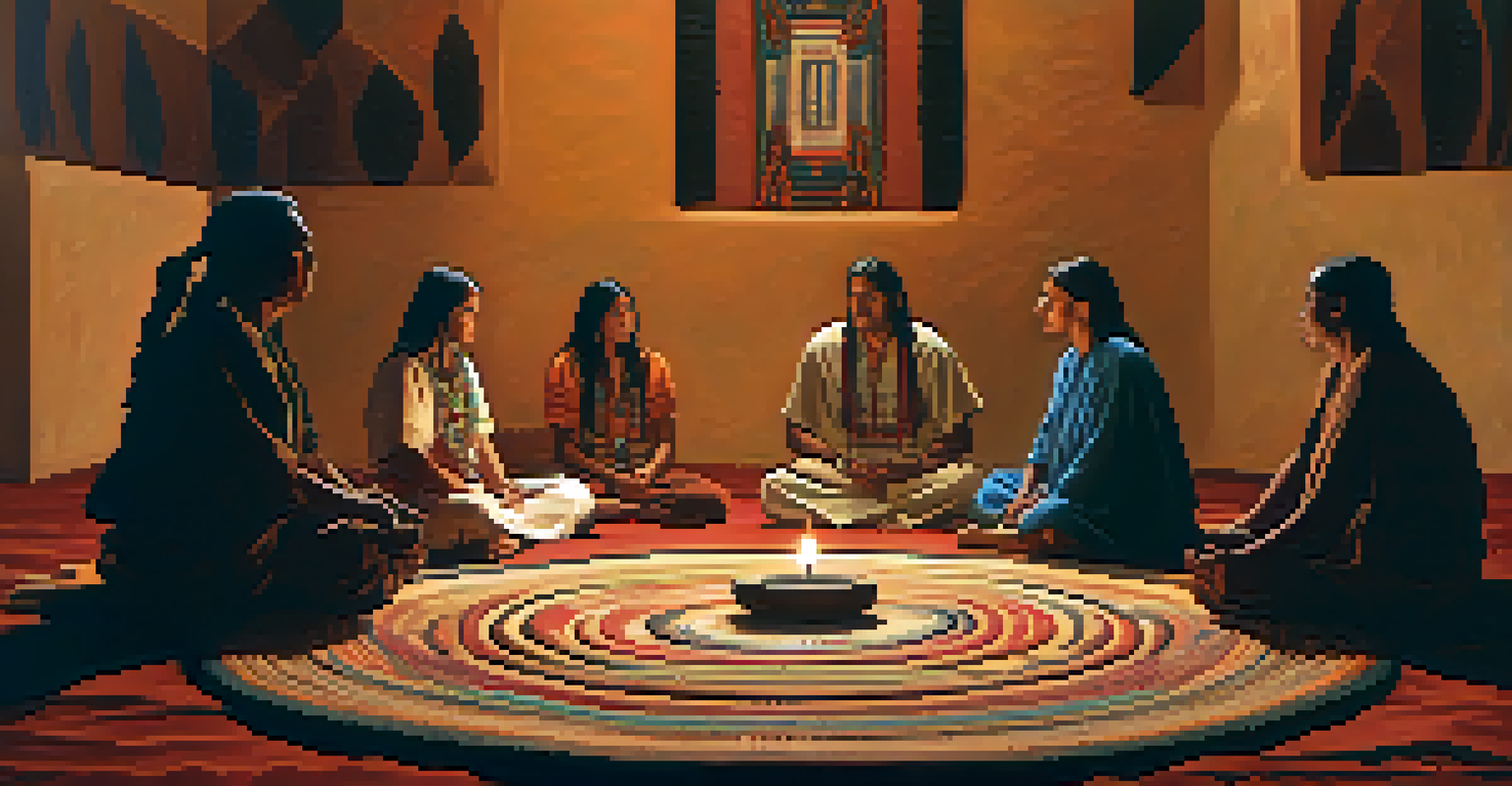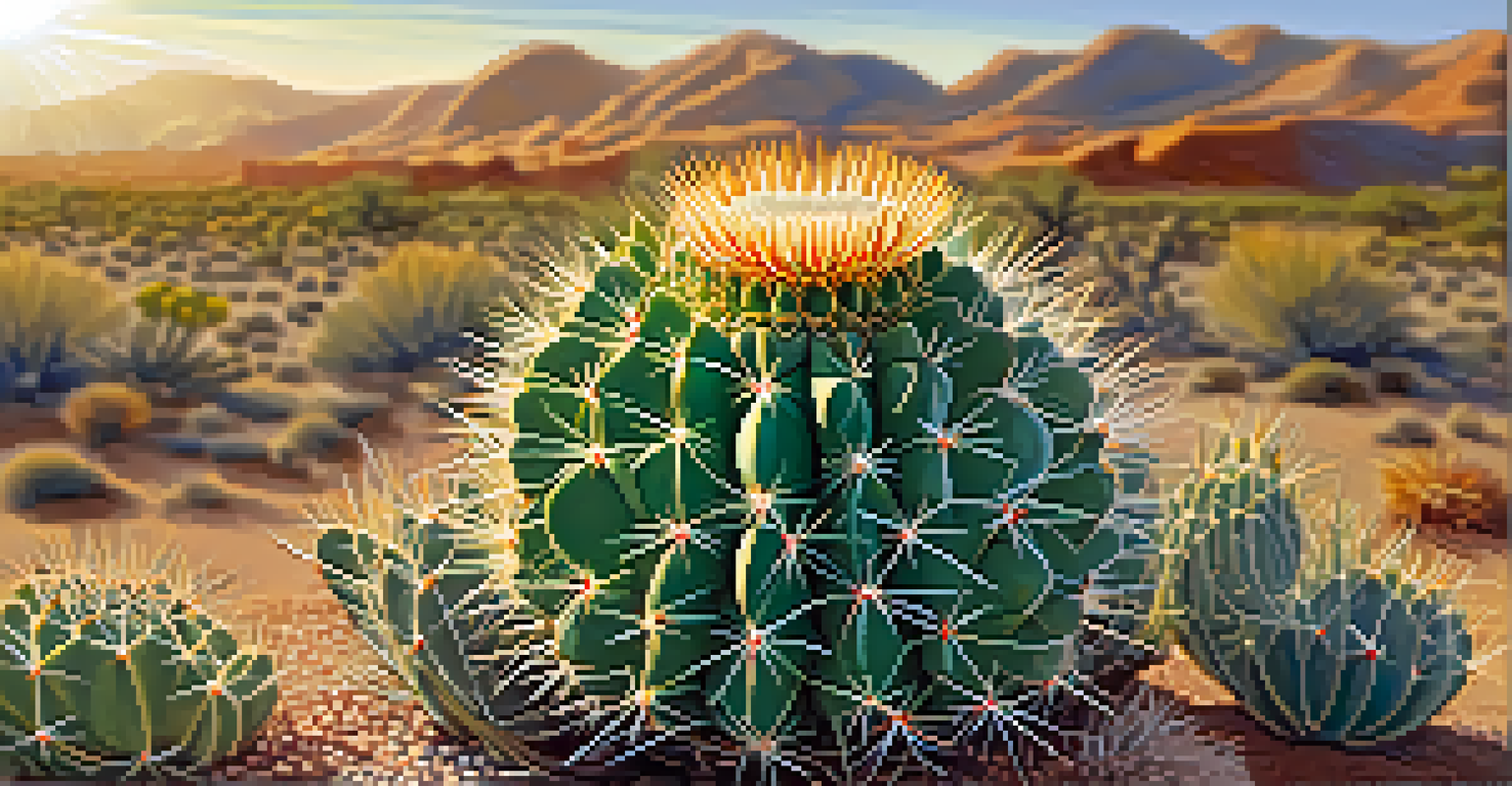Comparing Peyote and Other Psychedelics for Therapy

Understanding Peyote and Its Traditional Uses
Peyote, a small cactus native to Mexico and the southwestern United States, has been used for centuries in Native American spiritual ceremonies. Its psychoactive compound, mescaline, induces vivid visions and profound insights, making it a central element in various cultural rituals. By understanding its traditional context, we can appreciate how these practices have shaped modern therapeutic approaches.
The use of peyote as a sacrament in Native American traditions highlights the role of spirituality in healing.
In these ceremonies, participants often seek personal healing and community bonding, suggesting that the communal aspect plays a significant role in the therapeutic effects. This cultural significance can guide current therapeutic practices, emphasizing the importance of setting and intention. As we delve into the potential of Peyote in therapy, it’s crucial to recognize its roots in tradition and spirituality.
Moreover, the reverence for Peyote among indigenous communities highlights the need for ethical considerations in its therapeutic use. With growing interest in psychedelics, we must respect these traditions and the knowledge they hold. Balancing modern therapy with ancient practices may lead to more holistic healing approaches.
Psychedelics in Modern Therapy: An Overview
Psychedelics, including LSD, psilocybin (magic mushrooms), and ayahuasca, are gaining traction in therapeutic settings. These substances have shown promise in treating conditions such as PTSD, depression, and anxiety. Recent studies indicate that they can help break down mental barriers and foster emotional breakthroughs, leading to lasting change.

Each psychedelic offers a unique experience and mechanism of action. For instance, while LSD may provide a more energetic experience, psilocybin often leads to introspection and emotional release. Understanding these differences can help therapists tailor their approaches, ensuring that patients receive the best possible care.
Peyote's Cultural Significance
Peyote holds deep spiritual roots in Native American traditions, influencing modern therapeutic practices through its communal and healing aspects.
Additionally, the resurgence of interest in psychedelics has sparked important conversations about legality and accessibility. As more research emerges, there is hope for a future where these substances can be safely integrated into mainstream mental health care. This evolution could pave the way for innovative treatment options that prioritize well-being.
The Science Behind Peyote: How It Works
Peyote's primary active ingredient, mescaline, interacts with serotonin receptors in the brain. This interaction can lead to altered perceptions, enhanced emotional experiences, and changes in thought patterns. Such effects can facilitate deep introspection, making it a valuable tool for therapy.
Psychedelics can be a window into the mind, allowing us to confront our deepest fears and traumas.
Research suggests that mescaline can help individuals confront unresolved issues and traumas. By providing a new perspective on personal challenges, patients may find clarity and healing. This therapeutic potential is one reason why Peyote is being considered alongside other psychedelics in modern mental health practices.
Moreover, the physiological effects of Peyote can also encourage a sense of connection to nature and others. This feeling of interconnectedness can be incredibly therapeutic, fostering compassion and understanding. As we explore these substances, it’s essential to consider both the mental and physical dimensions of their therapeutic effects.
Comparative Benefits: Peyote vs. Other Psychedelics
When comparing Peyote to other psychedelics, one must consider the subjective experiences each can provide. Peyote often offers a more grounded and introspective journey, whereas substances like LSD can lead to more expansive and energetic trips. Understanding these nuances can help therapists guide patients toward the most suitable option for their healing.
Additionally, the duration of effects varies significantly among these substances. Peyote's effects typically last around 10 to 12 hours, while psilocybin’s effects may last 4 to 6 hours. This difference can influence the therapeutic setting, as longer sessions may allow for deeper exploration of emotional or psychological issues.
Therapeutic Potential of Psychedelics
Psychedelics like Peyote show promise in treating mental health conditions by facilitating emotional breakthroughs and personal insights.
Ultimately, the choice between Peyote and other psychedelics should consider individual preferences, therapeutic goals, and the specific challenges faced by the patient. By tailoring the psychedelic experience to the individual's needs, therapists can enhance the potential for meaningful healing.
Risks and Considerations with Peyote Use
While Peyote and other psychedelics offer therapeutic benefits, they are not without risks. Possible side effects can include nausea, anxiety, and confusion, especially for those unprepared for the intensity of the experience. It's essential for therapists and patients to discuss these risks openly before embarking on a psychedelic journey.
Additionally, there are legal and ethical considerations surrounding the use of Peyote in therapy. In many places, it remains illegal outside of specific ceremonial contexts, which can complicate access for those seeking treatment. Therapists must navigate these legal frameworks carefully to provide safe and effective care.
Furthermore, individual mental health history plays a crucial role in determining whether Peyote is a suitable option. Those with a history of psychosis or severe anxiety may not be ideal candidates for this type of therapy. A thorough assessment can help ensure that patients are matched with the right therapeutic approach.
The Role of Set and Setting in Peyote Therapy
The concept of 'set and setting' is vital when discussing Peyote therapy. 'Set' refers to the individual's mindset and expectations, while 'setting' encompasses the physical and social environment in which the experience takes place. Both factors significantly influence the outcome of a psychedelic experience.
Creating a supportive and safe environment can enhance the therapeutic effects of Peyote. This includes having a trained facilitator present, using calming music, and ensuring a comfortable space. By carefully curating the setting, therapists can help patients navigate their experiences with greater ease.
Importance of Set and Setting
The success of Peyote therapy hinges on the individual's mindset and the physical environment, emphasizing the need for careful preparation.
Moreover, preparing the mind through intention-setting can lead to more meaningful insights during the journey. Encouraging patients to clarify their goals and what they hope to achieve can facilitate a more focused and productive experience. This emphasis on preparation can make all the difference in the therapeutic process.
Future Directions for Peyote and Psychedelic Research
As interest in psychedelics continues to grow, research into Peyote and its therapeutic applications is gaining momentum. Scientists are exploring its effects on various mental health conditions, aiming to build a robust body of evidence to support its use. This research could lead to more comprehensive treatment frameworks that include Peyote alongside other psychedelics.
Furthermore, there is a push for integrating indigenous knowledge into modern therapeutic practices. Collaborating with native communities can provide valuable insights into the traditional uses and benefits of Peyote, enriching our understanding of its potential. This approach not only honors these traditions but also fosters ethical considerations in research.

Ultimately, the future of Peyote in therapy will depend on continued research, open dialogue, and a commitment to ethical practices. As we learn more about these powerful substances, we may uncover new pathways for healing that can transform mental health care.